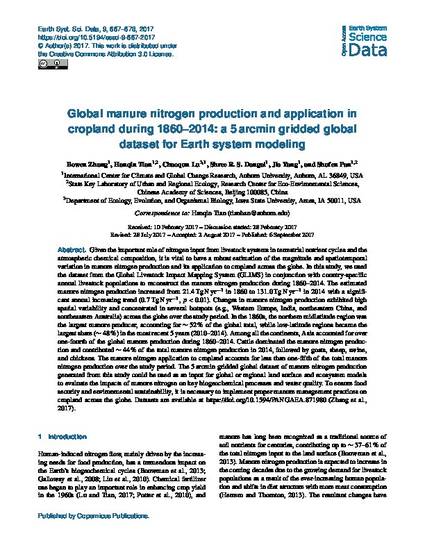
Given the important role of nitrogen input from livestock systems in terrestrial nutrient cycles and the atmospheric chemical composition, it is vital to have a robust estimation of the magnitude and spatiotemporal variation in manure nitrogen production and its application to cropland across the globe. In this study, we used the dataset from the Global Livestock Impact Mapping System (GLIMS) in conjunction with country-specific annual livestock populations to reconstruct the manure nitrogen production during 1860–2014. The estimated manure nitrogen production increased from 21.4TgNyr−1 in 1860 to 131.0TgNyr−1 in 2014 with a significant annual increasing trend (0.7TgNyr−1, p< 0.01). Changes in manure nitrogen production exhibited high spatial variability and concentrated in several hotspots (e.g., Western Europe, India, northeastern China, and southeastern Australia) across the globe over the study period. In the 1860s, the northern midlatitude region was the largest manure producer, accounting for ∼ 52% of the global total, while low-latitude regions became the largest share (∼48%) in the most recent 5 years (2010–2014). Among all the continents, Asia accounted for over one-fourth of the global manure production during 1860–2014. Cattle dominated the manure nitrogen production and contributed ∼ 44% of the total manure nitrogen production in 2014, followed by goats, sheep, swine, and chickens. The manure nitrogen application to cropland accounts for less than one-fifth of the total manure nitrogen production over the study period. The 5arcmin gridded global dataset of manure nitrogen production generated from this study could be used as an input for global or regional land surface and ecosystem models to evaluate the impacts of manure nitrogen on key biogeochemical processes and water quality. To ensure food security and environmental sustainability, it is necessary to implement proper manure management practices on cropland across the globe. Datasets are available at https://doi.org/10.1594/PANGAEA.871980 (Zhang et al., 2017).
Available at: http://works.bepress.com/chaoqun_lu/34/

This article is published as Zhang, B., H. Tian, C. Lu, S. R. S. Dangal, J. Yang, and S. Pan. 2017. Global manure nitrogen production and application in cropland during 1860–2014: a 5-arcmin gridded global dataset for Earth system modeling. Earth System Science Data, 9: 667-678. Doi: 10.5194/essd-9-667-2017.